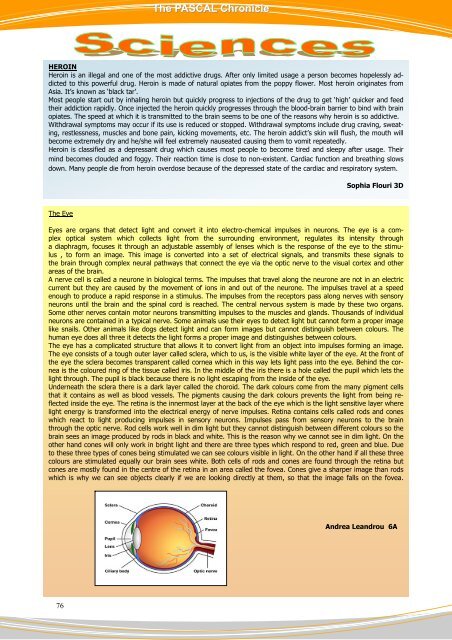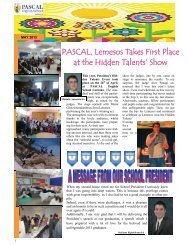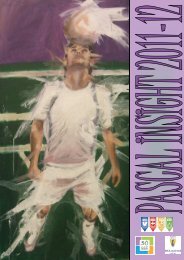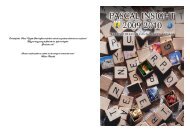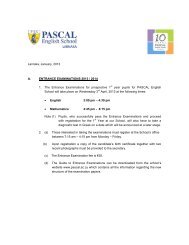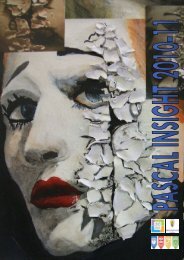Chronicle
The PASCAL Chronicle 2012-13 - Pascal Education
The PASCAL Chronicle 2012-13 - Pascal Education
You also want an ePaper? Increase the reach of your titles
YUMPU automatically turns print PDFs into web optimized ePapers that Google loves.
The PASCAL <strong>Chronicle</strong>HEROINHeroin is an illegal and one of the most addictive drugs. After only limited usage a person becomes hopelessly addictedto this powerful drug. Heroin is made of natural opiates from the poppy flower. Most heroin originates fromAsia. It’s known as ‘black tar’.Most people start out by inhaling heroin but quickly progress to injections of the drug to get ‘high’ quicker and feedtheir addiction rapidly. Once injected the heroin quickly progresses through the blood-brain barrier to bind with brainopiates. The speed at which it is transmitted to the brain seems to be one of the reasons why heroin is so addictive.Withdrawal symptoms may occur if its use is reduced or stopped. Withdrawal symptoms include drug craving, sweating,restlessness, muscles and bone pain, kicking movements, etc. The heroin addict’s skin will flush, the mouth willbecome extremely dry and he/she will feel extremely nauseated causing them to vomit repeatedly.Heroin is classified as a depressant drug which causes most people to become tired and sleepy after usage. Theirmind becomes clouded and foggy. Their reaction time is close to non-existent. Cardiac function and breathing slowsdown. Many people die from heroin overdose because of the depressed state of the cardiac and respiratory system.Sophia Flouri 3DThe EyeEyes are organs that detect light and convert it into electro-chemical impulses in neurons. The eye is a complexoptical system which collects light from the surrounding environment, regulates its intensity througha diaphragm, focuses it through an adjustable assembly of lenses which is the response of the eye to the stimulus, to form an image. This image is converted into a set of electrical signals, and transmits these signals tothe brain through complex neural pathways that connect the eye via the optic nerve to the visual cortex and otherareas of the brain.A nerve cell is called a neurone in biological terms. The impulses that travel along the neurone are not in an electriccurrent but they are caused by the movement of ions in and out of the neurone. The impulses travel at a speedenough to produce a rapid response in a stimulus. The impulses from the receptors pass along nerves with sensoryneurons until the brain and the spinal cord is reached. The central nervous system is made by these two organs.Some other nerves contain motor neurons transmitting impulses to the muscles and glands. Thousands of individualneurons are contained in a typical nerve. Some animals use their eyes to detect light but cannot form a proper imagelike snails. Other animals like dogs detect light and can form images but cannot distinguish between colours. Thehuman eye does all three it detects the light forms a proper image and distinguishes between colours.The eye has a complicated structure that allows it to convert light from an object into impulses forming an image.The eye consists of a tough outer layer called sclera, which to us, is the visible white layer of the eye. At the front ofthe eye the sclera becomes transparent called cornea which in this way lets light pass into the eye. Behind the corneais the coloured ring of the tissue called iris. In the middle of the iris there is a hole called the pupil which lets thelight through. The pupil is black because there is no light escaping from the inside of the eye.Underneath the sclera there is a dark layer called the choroid. The dark colours come from the many pigment cellsthat it contains as well as blood vessels. The pigments causing the dark colours prevents the light from being reflectedinside the eye. The retina is the innermost layer at the back of the eye which is the light sensitive layer wherelight energy is transformed into the electrical energy of nerve impulses. Retina contains cells called rods and coneswhich react to light producing impulses in sensory neurons. Impulses pass from sensory neurons to the brainthrough the optic nerve. Rod cells work well in dim light but they cannot distinguish between different colours so thebrain sees an image produced by rods in black and white. This is the reason why we cannot see in dim light. On theother hand cones will only work in bright light and there are three types which respond to red, green and blue. Dueto these three types of cones being stimulated we can see colours visible in light. On the other hand if all these threecolours are stimulated equally our brain sees white. Both cells of rods and cones are found through the retina butcones are mostly found in the centre of the retina in an area called the fovea. Cones give a sharper image than rodswhich is why we can see objects clearly if we are looking directly at them, so that the image falls on the fovea.Andrea Leandrou 6A76


